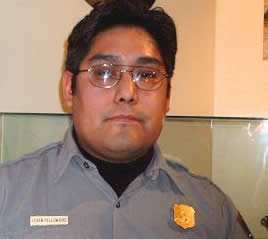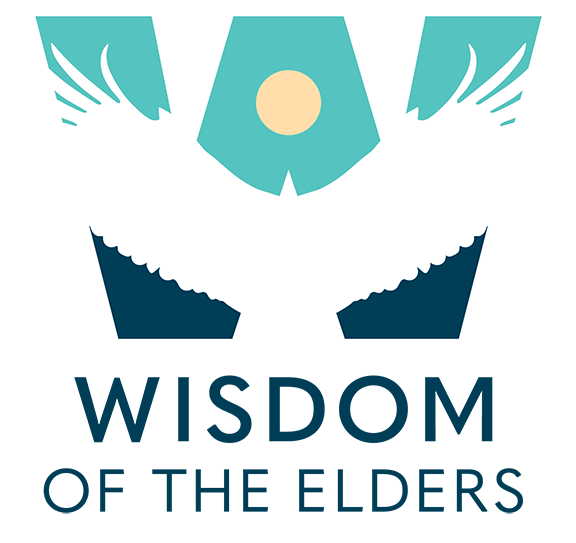Loren Yellow Bird
 My name is Loren Yellow Bird. I’m a member of the Arikara tribe. I work for the National Park Service. If you’d say that in the Arikara language or Sahnish is what we say, I’d say (speaks in language).
My name is Loren Yellow Bird. I’m a member of the Arikara tribe. I work for the National Park Service. If you’d say that in the Arikara language or Sahnish is what we say, I’d say (speaks in language).
We go back to what we call our chiefs and our leaders that way. Most chiefs have to do something to try to prove themselves and it’s just to show that they can take care of their people. I mean it, politicians, you know, it’s that type of thing where you gotta try to do things to show that you care about who you’re expecting to take care of.
(56:20) Now with that in mind, when I look back about our ability, it gets back to people like White Shield or another man by the name of Son of the Star, his son. They were really instrumental in getting us and trying to help preserve our way of life. There was a point in our history where our tribe basically was wiped out through smallpox. We were vulnerable against their enemies. So they negotiated for us a lot of things.
(56:57) So what that does is it kind of brings me back to when I do think about Lewis and Clark, that period, and what our chiefs tried to do. One in mind is the one they call Piahitu, or Eagle Feather. He went with them and he went down to St. Louis and of course, the Corps of Discovery was going on their trip yet. He journeyed down and eventually, he got sick and died. So to go to great lengths like that to try to establish some kind of relationship for your people. It shows great character and people obviously cared about him enough to be upset about it.
When Lewis and Clark described meeting them, they figured twenty-five hundred people, maybe three thousand. They could probably muster anywhere from six to eight hundred warriors, something like that, I mean. ‘Course I think Clark was real observant as far as what type of numbers were out there like that. One of their lead interpreters was a Frenchman. Tibeau was one of them and he talked about this tribe was larger than this at one time.
So what you are getting and what they noted it in their journals, talking about there were some disagreements between chiefs because of who wanted to be leaders, or some of them that died off. So that was what was left and that type of thing. There was some indication that way how that smallpox affected our leadership, but to try to get through that and deal with other people was an important part too.
Loren Yellow Bird
Historian, storyteller, and song carrier, Loren Yellowbird, Sr. is a full-blooded Arikara from the Fort Berthold Reservation in North Dakota. Loren works at the Fort Union Trading Post for the National Park Service and lives in Williston, North Dakota. He is a father to five boys including a set of triplets. Chief Son of the Star is from his mother’s side of the family and Medicine Men Bears Teeth is from his father’s side. Migration of the tribe started in Nebraska following the Missouri River up into central North Dakota along the Missouri River and Lake Sacajewea. The reservation is divided into three tribes: Arikara in the east, Hidatsa in the west, and Mandan in the southern part of the reservation. Before the Garrison Dam was built, the Arikara lived along the river bottoms that consisted of flat farmland. After flooding, they relocated to the plains.
Loren relates the different aspects of Arikara history in his stories. He talks of creation and legend stories. Naaii`tuKux means true stories and Maa`eii kaits means fairy tales. Winter is the traditional storytelling time. He tells a story of how his ancestor Bears Teeth went out hunting with the Arikara and got separated from the main hunting party. He came to a lake and a horse came from the water. The horse said his people were waiting for him over the hill. He said he would show him how to get home, but first the horse wanted to show him how to take care of them and other animals. He returned and revealed what had happened to his people. From then on, he could do certain things to help his people, and always acknowledged certain animals that helped him.
He tells the traditional history of the tribe’s different dances. There are ceremonial dances, the grass dance, special dances of certain societies, and in the pow wow circuit, there’s the fancy dance. Loren explains that objects have a lot to do with helping describe history. He discusses farming implements, like the shoulder blade hoe, quill and beadwork, animal hide drawing, ledger work, earth lodges, and tribal pipes.
Loren is comfortable giving presentations to Indian and non-Indian audiences of all age groups and settings. As an interpreter, he takes all elements into consideration for programs. He’s also done recordings for the NPS for the Lewis and Clark Trail, technical recordings on earth lodges, and has had his singing recorded. Loren has received work-related awards from the NPS, the military, and college. He’s sat on committees, was president of Celebration one year, and third place commander for the American Legion. He has published a few items for the Native American Scholarly Journal by Arizona State, did a paper on Arikara Perspectives of Lewis and Clark, articles for the University of Montana, and the Buffalo Bill Historical Museum. He created a shamanism journal about indigenous tribes and their religion and has a pending publication titled “Arikara Veterans 1898 – 1998.
Loren Yellow Bird
15550 Highway 1804
Williston, ND 58807
701-572-9083
loren_yellow_bird@nps.gov
loreny@nemontel.net
